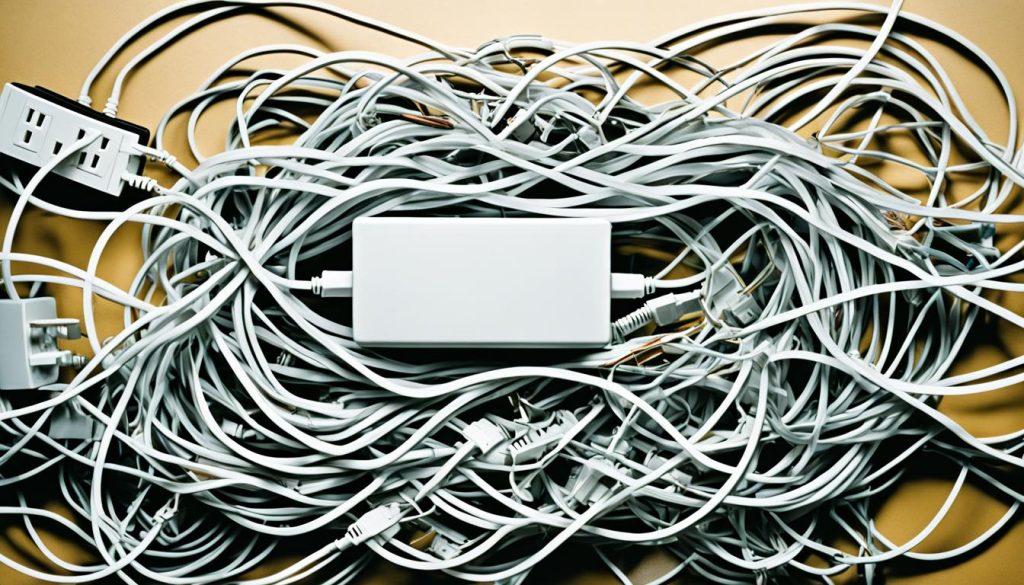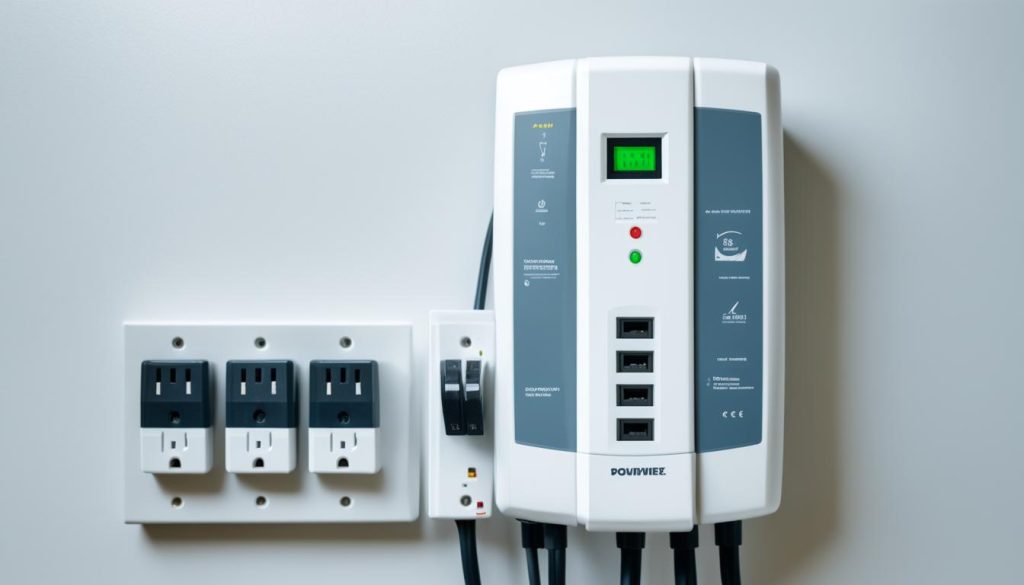Are you confused between a power tap and a surge protector? While they may look similar, they serve different purposes when it comes to electrical safety. Let’s dive into the key differences to help you make an informed decision about the best protection for your electronics.
Key Takeaways:
- A power strip simply adds extra outlet space, while a surge protector defends against voltage spikes that could damage your electronics.
- Power strips do not offer surge protection, leaving your devices vulnerable to power surges.
- Surge protectors have a joules rating that indicates the level of protection they provide against surges.
- Power strips are suitable for residential and commercial areas where extra outlets are needed, but surge protection is not a concern.
- Surge protectors are recommended when you have multiple appliances or electronics in close proximity to protect them from power surges.
Difference Between Power Strip and Surge Protector
When it comes to protecting your electronics from voltage spikes, it’s important to understand the difference between a power strip and a surge protector. While they may look similar, their functionality sets them apart.
A power strip, also known as a power tap, is essentially an extension cord with multiple outlets. It is designed to provide additional outlet space, allowing you to connect multiple devices to a single power source.
On the other hand, a surge protector goes a step further by offering surge protection. It includes an additional element that clamps down on voltage spikes, preventing them from damaging your valuable electronics. These voltage spikes, also known as power surges, can occur due to lightning strikes, faulty wiring, or other electrical disturbances.
One of the key features of a surge protector is its joules rating. This rating indicates the level of protection it provides against surges. The higher the joules rating, the more protection it offers. So, when choosing a surge protector, it’s important to consider the rating that aligns with the devices you want to protect.
It’s worth noting that power strips do not offer surge protection. They are solely useful for providing additional outlet space and convenience. While they can accommodate multiple devices, they do not have the same level of protection as surge protectors.
So, if you want to safeguard your electronics from voltage spikes and ensure their longevity, investing in a surge protector is essential. The surge protector will protect your devices by diverting excess voltage and providing a safe level of power.
Remember, when it comes to surge protection, not all surge protectors are created equal. Make sure to choose a surge protector with an appropriate joules rating that suits your needs and the requirements of your electronic devices.
When to Choose a Power Strip
Power strips are a convenient option if you have multiple electronics in close proximity to each other. They provide extra outlets and often include a circuit breaker and an on/off switch. Power strips are suitable for residential and commercial areas where two sockets may not be sufficient. However, it’s important to note that not all power strips offer surge protection, leaving your devices at risk of voltage spikes.
If you have a home office setup with a desktop computer, printer, monitor, and other peripherals, a power strip can provide the extra outlet space you need to keep everything powered and connected. In a commercial setting, power strips can be useful in conference rooms, workstations, and shared office spaces where multiple devices need to be plugged in.
A power strip with a circuit breaker is a safety feature that helps protect your electronics in case of a power overload. The circuit breaker automatically shuts off the power if the strip detects an electrical short or if you exceed its maximum capacity. This helps prevent overheating and potential fires.
Another convenient feature of power strips is the on/off switch. Instead of having to unplug each individual device, you can simply switch off the power strip when not in use. This not only saves energy but also provides an efficient way to manage multiple devices without hassle.
However, it’s worth noting that power strips do not offer the same level of protection against power surges as surge protectors. While power strips provide extra outlets and electrical convenience, they do not have the ability to suppress or divert voltage spikes that can damage your sensitive electronics.
Key Points to Remember:
- Power strips are a convenient option for areas with multiple electronics.
- They provide extra outlets and often have a circuit breaker and on/off switch.
- Power strips are suitable for residential and commercial settings.
- Not all power strips offer surge protection, so be cautious when using them with valuable electronics.

Expert Quote:
“Power strips provide additional outlets and electrical convenience, but they lack surge protection. It’s important to choose the right device for your needs and ensure the safety of your valuable electronics.”
When to Choose a Surge Protector
When you have multiple appliances or electronics in close proximity, a surge protector is a wise choice. Not only does it provide surge protection, but it also offers multiple electrical outlets, allowing you to connect and safeguard your valuable devices.
One important factor to consider when selecting a surge protector is the joules rating. The joules rating indicates the level of protection the surge protector can provide against power surges. The higher the joules rating, the greater the protection for your electronics.
Surge protectors are especially essential for protecting sensitive devices such as TVs, computers, and home entertainment systems. By using a surge protector, you can effectively safeguard these devices from harmful voltage spikes and ensure their longevity and optimal performance.
In addition to residential use, surge protectors are also crucial for larger operations that have major appliances or equipment. Commercial surge protectors are specifically designed with higher joules ratings and enhanced protection capabilities to meet the demands of professional settings. Some commercial surge protectors even come with warranties, providing added peace of mind.
Remember, electrical safety should never be compromised. Protect your valuable electronics and ensure the longevity of your appliances by choosing a surge protector that suits your specific needs.

Key Points:
- Surge protectors provide surge protection and multiple electrical outlets.
- The joules rating indicates the level of protection against power surges.
- Surge protectors are essential for protecting TVs, computers, and home entertainment systems.
- Commercial surge protectors offer greater protection for larger operations and may come with warranties.
Understanding Electrical Power Surges
An electrical power surge is a sudden increase in your building’s electrical current, exceeding the standard voltage level. These voltage spikes can have detrimental effects on your valuable electronics and appliances, potentially leading to costly repairs or replacements.
Power surges can be caused by various factors, such as faulty wiring, high-powered device motors, or even lightning strikes. When a surge occurs, it can send a wave of excess electricity through your electrical system, overwhelming and damaging connected appliances and devices.
To safeguard your electronics and appliances from the damaging effects of power surges, it is crucial to invest in surge protectors. Surge protectors are specifically designed to detect high-voltage spikes and divert them away from your valuable equipment. By absorbing and redirecting the excess electricity, surge protectors provide a crucial line of defense against potential damage.
Understanding the distinction between power strips and surge protectors is crucial when it comes to securing the ideal level of protection for your electrical devices. While power strips offer convenience by providing additional outlets, they provide no defense against power surges. Therefore, it is essential to distinguish between the two and ensure that surge protectors are appropriately installed to safeguard your electronics and promote electrical safety in your home or office.
For comprehensive protection, consider employing a Whole House Surge Protector. This device guards all the circuitry in your residence or commercial space from power surges originating from utility services. With a Whole House Surge Protector in place, you can rest assured that all electrical devices in your property are shielded against damaging electrical power surges.
FAQ
What is the difference between a power strip and a surge protector?
A power strip simply adds extra outlet space, while a surge protector defends against voltage spikes that could damage your electronics. Power strips do not offer surge protection.
What is the joules rating on surge protectors?
The joules rating measures how long your appliances are protected against power surges.
Are power strips suitable for surge protection?
No, power strips do not offer surge protection and can leave your devices vulnerable to voltage spikes.
When should I use a power strip?
Power strips are a convenient option if you have multiple electronics in close proximity to each other and need extra outlets. They may include a circuit breaker and an on/off switch.
When should I choose a surge protector?
Surge protectors are recommended when you have multiple appliances or electronics in close proximity, as they provide surge protection and multiple electrical outlets. The joules rating indicates the level of protection against power surges.
What is an electrical power surge?
An electrical power surge is a spike in your building’s electrical current that can cause damage to your electronics and appliances. It can occur due to faulty wiring, high-powered device motors, or lightning strikes.


